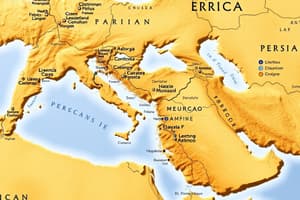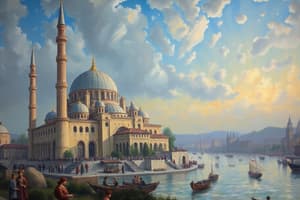Podcast
Questions and Answers
What was a significant feature of the Qing Dynasty?
What was a significant feature of the Qing Dynasty?
- Its location in South Asia
- Its expansion through naval power
- Its use of the devshirme system
- Its ethnic differences from its subjects (correct)
What was a common method used by rulers of land-based empires to legitimize and consolidate their power?
What was a common method used by rulers of land-based empires to legitimize and consolidate their power?
- The use of gunpowder weapons
- The use of the divine right of kings
- The formation of large bureaucracies and development of military professionals (correct)
- The intensification of the Sunni-Shia split
What was used by the Ottoman Empire to staff their bureaucracy?
What was used by the Ottoman Empire to staff their bureaucracy?
- The divine right of kings
- The devshirme system (correct)
- Tribute lists
- The zamindar system
What marked a blending of Hindu and Islamic doctrines in South Asia?
What marked a blending of Hindu and Islamic doctrines in South Asia?
What was a result of the Protestant Reformation led by Martin Luther?
What was a result of the Protestant Reformation led by Martin Luther?
What was used by the Inca Empire to legitimize their power?
What was used by the Inca Empire to legitimize their power?
What is the primary characteristic that defines a land-based empire?
What is the primary characteristic that defines a land-based empire?
Which of the following empires was known for its tolerance of different belief systems?
Which of the following empires was known for its tolerance of different belief systems?
What was the name of the elite fighting force created by the Ottoman Empire through enslaving Christians and converting them to Islam?
What was the name of the elite fighting force created by the Ottoman Empire through enslaving Christians and converting them to Islam?
Which of the following empires was founded in the 14th century and expanded rapidly due to the adoption of gunpowder weapons?
Which of the following empires was founded in the 14th century and expanded rapidly due to the adoption of gunpowder weapons?
What was the significance of the Ottoman Empire's conquest of Constantinople in 1453?
What was the significance of the Ottoman Empire's conquest of Constantinople in 1453?
What was the difference between the Ottoman Empire's enslaved army and the Safavid Empire's enslaved army?
What was the difference between the Ottoman Empire's enslaved army and the Safavid Empire's enslaved army?
Flashcards are hidden until you start studying
Study Notes
Here is a summary of the text in detailed bullet points:
• The time period of 1450 to 1750 is characterized by the expansion, administration, and belief systems of land-based empires.
• A land-based empire is defined as an empire whose power comes from the extent of its territorial holdings.
• Four major empires of this period are the Ottoman Empire, the Safavid Empire, the Mughal Empire, and the Qing Dynasty.
• The Ottoman Empire was founded in the 14th century and expanded rapidly due to the adoption of gunpowder weapons, controlling much of Southwestern Europe and Anatolia by the beginning of the 15th century.
• The Ottoman Empire conquered Constantinople in 1453 and renamed it Istanbul, marking a significant expansion into Eastern Europe.
• The Ottomans also had a policy of enslaving Christians and converting them to Islam, creating an elite fighting force known as the janissaries.
• The Safavid Empire was founded in the 16th century and expanded rapidly through the use of gunpowder weapons, with a significant difference being that they were Shia Muslims, unlike the Sunni Ottoman Empire.
• The Safavid Empire also established an enslaved army, similar to the Ottomans, but composed of Christians from the Caucasus region.
• The Mughal Empire was established in the 16th century in South and Central Asia, and expanded rapidly through the use of gunpowder weapons, with a significant feature being its tolerance of different belief systems under the leadership of Akbar.
• The Qing Dynasty, also known as the Manchu Empire, was established in the 17th century in China, and expanded rapidly through the use of gunpowder weapons, with a significant feature being its ethnic differences from its subjects.
• All four empires expanded rapidly during this period, used gunpowder to achieve expansion, and had ethnically different rulers from their subjects.
• The Safavid-Mughal conflict was a series of wars fought over territory in what is today Afghanistan, with a significant religious element due to the Shia-Sunni split.
• Rulers of land-based empires legitimized and consolidated their power through four major ways: formation of large bureaucracies, development of military professionals, use of religious ideas, art, and monumental architecture, and innovations in tax collection systems.
• The Ottoman Empire used the devshirme system to staff their bureaucracy with highly trained individuals, while the Mughal Empire used the zamindar system to collect taxes from peasants.
• European monarchs used the divine right of kings to legitimize their authority, while the Qing Dynasty used Imperial portraits and monumental architecture to legitimize their power.
• The Inca Empire used monumental architecture to legitimize their power, while the Palace of Versailles was used to consolidate power under Louis XIV.
• The Aztec Empire used tribute lists to generate revenue for their empire.
• Christianity in Europe underwent significant changes during this period, with the Protestant Reformation led by Martin Luther, which resulted in a permanent split between Catholic and Protestant branches.
• The Roman Catholic Church continued as a dominant expression of Christian Christianity in Europe, but underwent reforms to address corruption and reaffirmed their doctrine of salvation.
• Islam underwent significant changes during this period, with the intensification of the Sunni-Shia split due to political rivalries among Islamic empires.
• The development of Sikhism in South Asia marked a blending of Hindu and Islamic doctrines, demonstrating continuity with both belief systems while also marking a change.
Studying That Suits You
Use AI to generate personalized quizzes and flashcards to suit your learning preferences.




